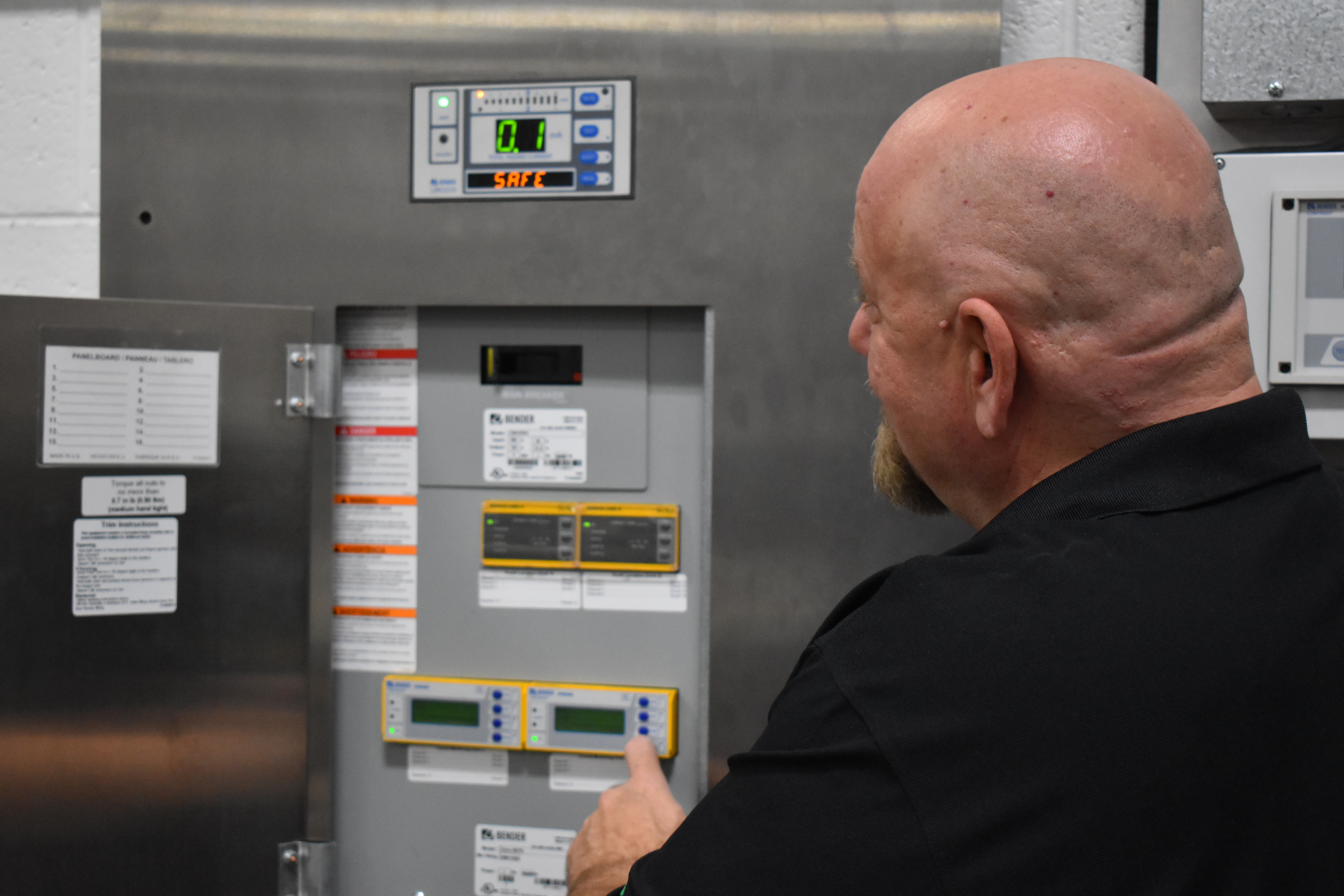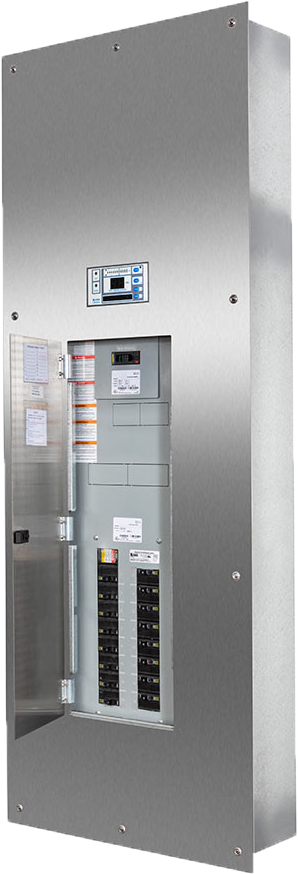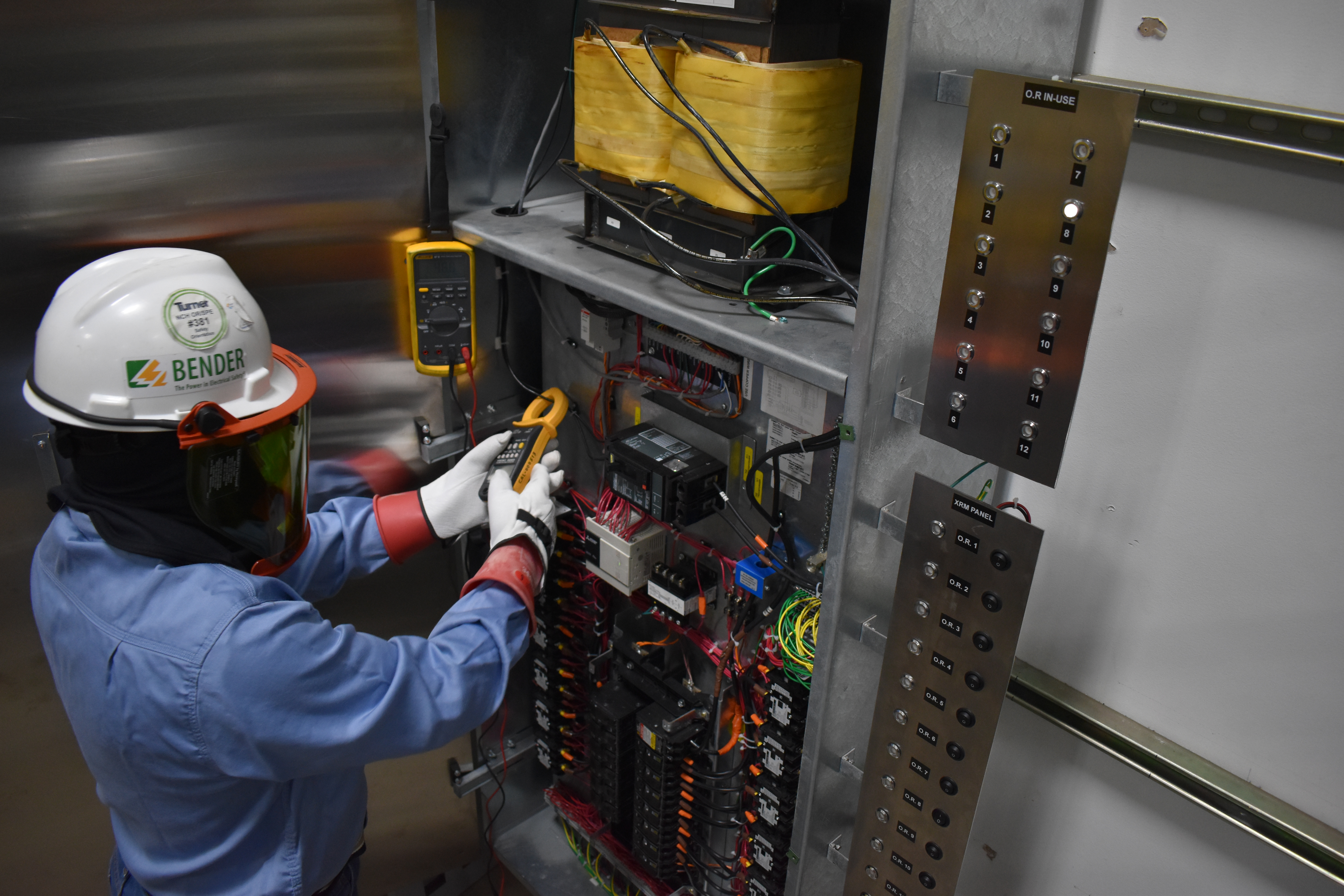

The Bender Service Team specializes in delivering high-quality Isolated Power Panel Testing and preventive maintenance solutions to optimize equipment performance when you need it most. With every new equipment installation, we offer on-site start-up commissioning, Line Isolation Monitor (LIM) Testing & Recertification, and comprehensive compliance testing to ensure adherence to NFPA-99, NEC, and JCAHO standards. For qualifying IPS components, we provide an exclusive 5-year warranty activated upon successful commissioning by our certified technicians. Our team goes the extra mile by offering training sessions for your hospital staff, ensuring they have the knowledge required for the proper use and care of your isolated power system.

In healthcare facilities, NFPA requires regular testing of isolated power systems to ensure they are in peak condition, keeping patients and staff safe. Bender offers a complete range of services to validate the state of these systems and ensure certification of meeting NFPA, NEC, and JCAHO regulations and standards.
Per NFPA 99:2015 Article 6.3.4.1.5, facilities must perform testing using external simulated faults after any system modification, repair, or renovation. Bender field service technicians provide recertification testing for any manufacture and model of Isolated Power. Although a facility can perform its own “in-house” testing on their LIMs (Line Isolation Monitors) utilizing a Bender LIM tester, this is not recommended due to the infrequency of testing needed and tools required to test correctly. It is recommended to use in-house testing to supplement the more thorough testing performed by a qualified, reputable service provider.
On-site start-up commissioning and LIM recertification and testing by a Bender technician is offered with all equipment sales for new installations. Bender offers an exclusive 5-year warranty on qualifying IPS (Isolated Power System) components, which is applied based upon successful commissioning by a Bender certified technician.
For new installation, please refer to the Site Readiness Pre-Checklist for instructions to ensure proper preparation prior to field service technician dispatch to the site.

Bender provides complete services for upgrading and updating isolated power systems without the need to replace entire panels. Upgrading to Bender's LIM2010 Line Isolation Monitor and MK2000 series remote annunciators eliminates issues associated with aging systems and reduces testing costs.
We can retrofit any existing make or model of Line Isolation Monitor and remote annunciator. With many common models having available retrofit kits—and custom solutions for unique situations—our service engineers will guide you through the evaluation, planning, and implementation process to ensure an efficient, minimally disruptive upgrade.
NFPA 99 requires periodic testing of all isolated power systems in healthcare facilities. Our authorized technicians are available to perform annual testing on any make or model of isolated power panel and bi-annual testing of analog Line Isolation Monitors. Our recertification services include:
If any issues are detected in the system during testing, onsite technicians will assess for the best solutions that will be documented and then included with the recertification report.
Our certified technicians offer Certification Field Testing Services for all makes and models of isolated power panels. To comply with NFPA 99, every new installation must be factory certified prior to being put into service. Our field testing includes:

Technicians can also advise hospital staff on annual recertification options, including multi-year agreements, to ensure the continued compliance and proper function of all equipment.
For new installation please refer to the Site Readiness Pre-Checklist for instructions to ensure proper preparation prior to Field Service Technician dispatch to site.
Looking to add or expand your isolated power system? Bender’s expert engineers are here to guide you through every step of designing an effective and safe system. Our consulting services include:
For new installations, please refer to the Site Readiness Pre-Checklist for preparation instructions prior to dispatching our field service technicians.
Our Bender certified technicians are factory-trained in every make and model of isolated power systems. We offer flexible scheduling options—including after-hours and weekend services—to ensure your testing and recertification needs are met without disrupting your facility operations.
Our commitment to rapid turnaround, seamless service delivery, and advanced technology ensures you get the best value and performance for your investment.
Ready to ensure your facility’s compliance and performance?
Request Your NFPA-Compliant Isolated Power Panel Test Today.
It is recommended to avoid using the transformer compartment as a "wire way" for conductors. In the event that wire must be run in the transformer compartment the following must be adhered:
- Limit the amount of cross wiring as much as possible
- Maintain segregation by separation between the Grounded (Main) conductors and all ungrounded (branch) conductors
Conductor Identification requirements for isolated (ungrounded) conductors of Isolated Power Systems are identified in NFPA 70 (NEC) in Article 517.160.
NFPA 70 (2008 - current)
Isolated Conductor No. 1 — Orange with at least one distinctive colored stripe other than white, green, or gray along the entire length of the conductor
Isolated Conductor No. 2 — Brown with at least one distinctive colored stripe other than white, green, or gray along the entire length of the conductor
NFPA 70 (2005)
Isolated Conductor No. 1 — Orange
Isolated Conductor No. 2 — Brown
It is recommended to avoid using ANY wire pulling compound for isolated (ungrounded) conductors of an Isolated Power System.
Wire-Pulling Compound requirements for isolated (ungrounded) conductors of Isolated Power Systems is identified in NFPA 70 (NEC) in Article 517.160.
- Compounds that increase the dielectric constant shall NOT be used on the secondary conductors of the isolated power supply.
- Compounds known to increase the dielectric constant include but are not limited to:
- Polymer/Water Types
- Wax/Wax Soap Types
- Dry Talc Types (results in minimal increase in dielectric constant)
Each termination and splice of a conductor decreases the impedance of the circuit.
It is recommended to avoid wire splicing for isolated (ungrounded) conductors of an Isolated Power System. In the event that wire splicing is unavoidable it is recommended to:
- Utilize compression type terminals only.
The quantities will, except for rare occasions, not be equal for several reasons: 1. The proximity of each (L1 and L2) conductor to ground will be different when running the wires in conduit; therefore, the line-to-ground capacitance will also be different. Running twisted pairs of conductors (twisted) at roughly 2-foot intervals is a good approach for achieving symmetrical line-to-ground capacitances. 2. Not all circuits have loads that can be turned ON and OFF with DPST (double pole single throw) switches. Therefore, loads with SPST (single pole single throw) switches that are in the OFF state add to the line-to-ground capacitance between only one of the isolated power conductor and ground. 3. Loads are often designed to be powered from a grounded instead of an isolated supply. A line-to-ground filter is often added between the HOT wire and ground. This approach for attenuating electrical noise further adds to the asymmetry between line-to-ground capacitances.
No.
Ground-Fault Circuit-Interrupters (GFCIs) are intended for protection of personnel, for use only in grounded neutral systems in accordance with the National Electrical Code (NEC).
Many power strips incorporate "surge suppression" by utilizing MOVs (metal oxide varistors) which are notorious for causing high levels of leakage currents. An isolated power system will not operate properly with a surge protective device installed.
Refer to individual detail drawings of the particular panel for the exact location of the main circuit breaker.
NEC-2011 Section 404.8(A) indicates the breaker's center of the operating handle, when it's in its highest position, shall be located no more than 2.0m (6ft 7in) above the floor.
No, locations not defined as “Operating Rooms” do not need to be served by a dedicated IPS.
480ft is recommended; see supplemental information
Yes.
Per (NEC-2011) 517.13(B)(1) an Insulated Equipment Grounding Conductor (sized in accordance with 250.122) is required to be directly connected to the following:
- the grounding terminals of all receptacles.
- metal boxes and enclosures containing receptacles
- all non–current-carrying conductive surfaces of fixed electrical equipment likely to become energized that are subject to personal contact, operating at over 100 volts
exception: an insulated equipment bonding jumper that directly connects to the equipment grounding conductor is permitted to connect the box and receptacle(s) to the equipment grounding conductor
No.
AHJs have the official authority and duty to enforce compliance with a standard or code, and to approve the use of systems.
BENDER is not the Authority Having Jurisdiction "AHJ". BENDER technicians evaluate and test the system for performance and installation deficiencies. Installation methods varying from the approved methods per NFPA 99 and NFPA 70 (NEC) are noted on the report.
Yes, the warranty will still be valid.
As per (NEC-2014) 517.16 Isolated Ground Receptacles shall not be installed within the patient care vicinity
THHN or TFFN conductors are recommended.
Up to 150 ft ---> up to 2 remotes ---> 18AWG
Up to 150 ft ---> 3 remotes ---> 16AWG
150 - 200ft ---> up to 2 remotes ---> 16AWG
150 - 200ft ---> 3 remotes ---> 14AWG